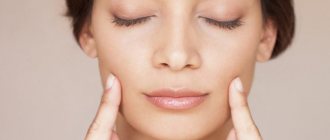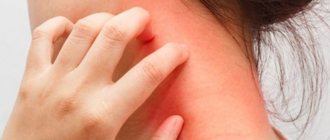Can vitamins cause acne*?
The appearance of acne is often associated with a deficiency of vitamins A, C, D, E, K, as well as B vitamins (B3, B5, B6, B9). Therefore, patients are prescribed vitamin complexes that can compensate for this deficiency. But they can also play a cruel joke. It turns out that acne* can appear from an overabundance of vitamins.18
In the course of research conducted by Californian scientists, it was found that one of the common provocateurs of acne is vitamin B12 (cobalamin). It is involved in the formation of red blood cells, ensures stable functioning of the metabolism and nervous system. Cobalamin is present in most vitamin complexes that patients with acne take. But it turns out that excess vitamin B12 can lead to worsening skin condition.
Cobalamin not only enters the body through food, but can also be produced by the bacteria P.acnes. But if the level of vitamin B12 in the blood serum increases, the “inhabitants” of the skin begin to produce less of it. Instead, they produce porphyrins, substances that promote inflammation. It is also believed that acne* may appear after taking vitamins B1, B2, B6, D2.18
Introduction
Acne is a chronic inflammatory disease of the pilosebaceous apparatus, which is equally observed in both sexes.
It is estimated that 75–95% of all adolescents suffer from acne to some degree [1]. This disease is characterized by non-inflammatory (white and black comedones) and inflammatory lesions (papules, pustules, nodules and/or cysts), which can negatively affect patients both psychologically and cosmetically due to the processes of scarring and pigmentation [2]. Acne has a multifactorial pathogenesis. There is follicular hyperkeratinization, colonization by Cutibacterium acnes (formerly known as Propionibacterium acnes) with subsequent inflammation. Acne is localized in areas with the largest number of sebaceous glands - mainly the face, back, chest and shoulders. Classification is important and helps in choosing treatment options [4].
Acne is classified according to severity as mild, moderate and severe. Typical mild acne lesions are characterized by the presence of closed and open comedones with a small amount of inflammatory elements and are limited to the facial area. Whereas with moderate acne, increased inflammation is observed with a large number of papules and pustules on the face.
The torso area may also be affected. Finally, the presence of nodules and cysts is a sign of severe acne. This is characterized by widespread damage to the torso area along with damage to the face. Vitamin D is a fat-soluble steroid hormone obtained from food and synthesized through the skin upon exposure to sunlight.
Vitamin D3 (cholecalciferol) and vitamin D2 (ergocalciferol) are produced by exposure to ultraviolet B radiation from the sun. Absorption of UV radiation by the skin leads to the conversion of provitamin D to pre-vitamin D, followed by the formation of vitamin D [3,6].
To assess vitamin D deficiency and insufficiency, serum 25-(OH)-D concentration is used as a biomarker. Due to its short half-life of approximately 15 hours, 1,25-(OH)-2D levels are not considered a good laboratory marker for determining vitamin D levels. In contrast, 25(OH)-D is more stable in the blood than 1. 25-(OH)-2D. Blood concentrations of 25(OH)-D are 500–1000 times higher than 1,25(OH)2D levels [7].
Vitamin D also affects the immune system. In addition, it regulates the proliferation and differentiation of keratinocytes and sebocytes. In addition, vitamin D has antioxidant and anti-comedogenic properties. Thus, vitamin D deficiency may contribute to the formation of acne. We aim to evaluate serum vitamin D [25(OH)D] levels in patients with acne and investigate the possibility of an existing relationship between low serum vitamin D levels and acne severity. To the best of our knowledge, such a study is believed to be the first in the Kingdom of Saudi Arabia.
Materials and methods
The study was conducted in the outpatient dermatology clinics of Qassim University, Saudi Arabia, between October 2016 and March 2022. It was approved by the local medical ethics committee of Qassim University College of Medicine and was in accordance with the Declaration of Helsinki.
The study was conducted during the winter season to minimize the effect of seasonal variations on serum vitamin D levels. The study included 68 patients with acne vulgaris (27 men and 41 women) and 50 healthy controls (24 men and 26 women). All patients in the study and control groups did not take any vitamin D supplements and did not suffer from any comorbidities with vitamin D deficiency.
Both groups underwent complete physical and clinical examinations and biochemical tests for serum vitamin D levels. Each study subject signed written informed consent and received a detailed explanation of the purposes and steps of this study.
Acne was classified as mild, moderate, or severe. Mild grade was considered to be <20 comedones, <15 inflammatory lesions, or total number of pathological elements <30. The average degree was characterized as the presence of 20–100 comedones, 15–50 inflammatory foci, or a total number of pathological elements of 30–125. Severe acne > 5 pseudocysts, total number of comedones > 100, total number of inflammatory elements > 50 or total number of pathological elements > 125) [9].
All 68 subjects completed questionnaires to demonstrate data on: family history of acne, sun exposure >2 hours per day, age of onset, duration of disease, location of acne (face, chest, and back), medical history, and other important variables.
Inclusion criteria
Male and female patients diagnosed with acne according to the Global Acne Score 6t English. global acne grading system, GAGS).
Non-inclusion criteria
Pregnant, breastfeeding, patients taking oral contraceptive pills, postmenopausal patients, patients taking corticosteroids or any medications that affect the metabolism of vitamin D (ketoconazole, rifampicin, phenytoin, isoniazid).
Patients taking vitamin D supplements, multivitamins. Patients suffering from active malignancy or other chronic systemic diseases. Patients regularly taking medications for other diseases, as well as patients who have taken isotretinoin orally within the past 3 months.
Lab tests
Study participants had their serum concentrations of 25-hydroxyvitamin D3 [25(OH)D] measured. Blood samples were collected from veins and analyzed within 24 hours of collection using a Roche Cobas e411 (Roche Diagnostics System, Switzerland). According to the recommendations of the Food and Nutrition Board of the Institute of Medicine, serum 25(OH)D levels were categorized as adequate (>20 ng/mL), reduced (12–20 ng) / ml) and deficiency (< 12 ng / ml) [10].
Statistical analysis
The recorded data were analyzed using specialized software 20.0 SPSS Inc., (Chicago, IL, USA). Analysis of variance (ANOVA) was performed. A significance level of p = 0.001 was considered significant, and p = 0.05 was considered insignificant.
results
This study included 68 patients with acne (41 women and 27 men) and 50 healthy controls (26 women and 24 men). Baseline demographic and clinical characteristics of participants are presented in Table 1. Acne patients were younger than control participants. Fourteen acne patients (20.5%) and twelve healthy subjects (24%) were exposed to sunlight for an average of more than two hours per day (Table 1).
Laboratory results
Vitamin D concentration [25(OH)D]
There is a statistical difference between the serum concentrations of vitamin D [25(OH)D] of the two groups. Vitamin D levels were higher in healthy subjects than in patients with acne (p = 0.003) (Table 2). In addition, we did not determine a significant relationship between sun exposure (Fig. 1), gender and serum vitamin D [25(OH)D] concentration in patients with acne vulgaris (p = 0.199) (Table 3).
Although there was moderate statistical significance between males and females in the healthy control group (p value = 0.042) (Table 4). The study results showed that there was no association between serum vitamin D concentrations and acne severity (mild, moderate, and severe) in subjects in the study groups (p = 0.067) (Table 5). In addition, we found no significant differences between gender and serum vitamin D concentrations, or between mild, moderate, and severe acne severity (p = 0.349, 0.291, and 0.572, respectively) (Tables 6–8).
Discussion
To the best of our knowledge, this is the first such study in Saudi Arabia to evaluate serum vitamin D levels in patients with acne. There are several biological mechanisms by which vitamin D exerts its anti-inflammatory effects. These mechanisms support the theory of the immunoregulatory function of vitamin D and its anti-inflammatory effect in patients with acne. Vitamin D suppresses Th17 differentiation induced by Cutibacterium acne. Indeed, interleukin 17 (IL-17) is an inflammatory cytokine whose levels are elevated in patients with acne. Vitamin D reduces the expression of IL-17 [11].
In cultured sebocytes, vitamin D also reduces the expression of inflammatory cytokines such as IL-6, IL-8 and matrix metalloproteinase [9,12]. Other mechanisms contribute to the antimicrobial effect by inducing antimicrobial peptides, such as LL-37, in human sebocytes [13]. Our results showed that serum vitamin D concentrations in subjects in the control group were significantly higher than those in acne patients (p = 0.003). These results are consistent with several other studies that have shown that patients with acne do not experience increased serum vitamin D levels [8,14,15]. Since the purpose of the study is to analyze vitamin D levels in acne patients, our results showed that there was no association between sun exposure and improvement in vitamin D levels in acne patients (p = 0.546). This could possibly be explained by several factors, such as the effects of psychological stress and subjects' reluctance to spend long periods outdoors. This finding suggests a possible explanation for low vitamin D levels in acne patients.
Our results are consistent with those of Lim et al, who showed that lower serum vitamin D levels in patients with severe acne may be caused by psychological stress. Another factor in vitamin D deficiency is environmental factors such as the hot climate of Saudi Arabia and the Persian Gulf, especially in summer. Again, our results are similar to those of Al-Taiar et al., who shed light on vitamin D deficiency among adolescents despite abundant sunshine in the Gulf [16].
The same results were obtained in another study by Elmohsen et al. in Egypt. Scientists in this study found no significant association between sun exposure and increased serum vitamin D levels. This supports our view that environmental factors, such as the very hot climate in Arab countries, may contribute to a reduction in the likelihood and duration of sun exposure.
Among our patients, we did not find a significant association between vitamin D deficiency and gender (p = 0.199). Our results are similar to those of several studies [14,15,17,18]. The results of the current study showed that the mean vitamin D value was higher in moderate acne (31.4 ± 6.9) than in mild and severe acne (26 ± 9.4 and 28.4 ± 6.7, respectively) .
However, this difference was not statistically significant (p = 0.067). However, this may be explained by the small sample size of our study. Additionally, we did not find a significant association between vitamin D deficiency and acne vulgaris severity. This result is consistent with several other studies [8,19].
Conclusion
This study found statistically significant low serum vitamin D levels in patients with acne. This finding highlights the importance of screening patients with acne for vitamin D insufficiency and deficiency. Further large-scale clinical trials are needed to elucidate the importance of vitamin D in acne.
The authors suggest a possible role for vitamin D treatment in acne. Further clinical trials are required to determine the effectiveness of both topical vitamin D analogues and oral vitamin D supplements in treating acne.
Table 1. Demographic and clinical data of patients with acne and control participants
| Indicators | Acne patients (68) | Control group (50) |
| Floor Men Women | 27 (39.7%) 41 (60.3%) | 24 (48%) 26 (52%) |
| Age (years) | ||
| Male (mean ± SD) Female (mean ± SD) | 20.7±3.8 21.3±3.6 | 39.8±11.8 37.7±14.85 |
| Solar exposure ˃2 hours per day N (%) | 14 (20.5%) | 12(24%) |
| Family history of acne N (%) | 29(42.65%) | N.A. |
| Age of onset of disease, years | 16.55±4.99 | N.A. |
| Duration of disease, years (mean ± SD) | 4.8±0.8 | N.A. |
| Localization of acne Face N (%) Chest N (%) Back N (%) | 68(100%) 24(35.3%) 40(54.41) | N.A. |
| Disease severity Mild N (%) Average N (%) Heavy N (%) | 21 (30,88%) 26 (38,24%) 21 (30,88%) | N.A. |
Abbreviations: N, number; SD, standard deviation; %, percent; NA, not specified.
Table 2. Comparison of serum vitamin D levels in patients with acne and controls
| Indicators | Acne patients (68) | Control group (50) | p-value |
| Serum vitamin D level ng/ml (mean ± standard deviation) | 28.8±7.9 | 40±11.7 | 0.003** |
Note: **Significant differences P ≤ 0.005.
Table 3. Relationship between serum vitamin D levels and gender in patients with acne
| Indicators | Male patients with acne (27) | Female patients with acne (41) | p-value |
| Serum vitamin D level ng/ml (mean ± standard deviation) | 30.39±7.9 | 27.8±7.8 | 0.199 |
Table 4. Relationship between serum vitamin D levels and gender in control subjects
| Indicators | Men (24) | Women (26) | p-value |
| Serum vitamin D level ng/ml (mean ± standard deviation) | 36.3±10.26 | 29.3±12.2 | 0.042** |
Note: **Significant differences P ≤ 0.005.
Table 5. Relationship between serum vitamin D levels and acne severity .
| Indicators | Light (21) | Medium (26) | Heavy (21) | p-value |
| Serum vitamin D level ng/ml (mean ± standard deviation) | 26±9.4 | 31.4±6.9 | 28.4±6.7 | 0.067 |
Table 6. Relationship between serum vitamin D levels and gender in patients with mild acne .
| Indicators | Male patients with mild acne (8) | Female patients with mild acne (13) | p-value |
| Serum vitamin D level ng/ml (mean ± standard deviation) | 28.8±7.9 | 24±8.3 | 0.349 |
Table 7 . Relationship between serum vitamin D levels and gender in patients with moderate acne.
| Indicators | Male patients with moderate acne (8) | Female patients with moderate acne (18) | p-value |
| Serum vitamin D level ng/ml (mean ± standard deviation) | 33.6±6.9 | 30.4±6.8 | 0.291 |
Table 8. Relationship between serum vitamin D levels and gender in patients with severe acne
| Indicators | Male patients with severe acne (11) | Female patients with severe acne (10) | p-value |
| Serum vitamin D level ng/ml (mean ± standard deviation) | 29.2±5.7 | 27.5±7.9 | 0.572 |
Mistake #1. Not monitoring vitamin D levels
Vitamin D
has a positive effect on insulin resistance and metabolism, the body’s ability to resist acute respiratory viral infections and oxidative stress, and reduces the risk of developing cancer and abnormalities in fetal development during pregnancy. Moreover, “sunshine” vitamin D helps not to feel depressed and reduces pain during childbirth.
In regions with low levels of insolation (including St. Petersburg), vitamin D deficiency is extremely common. However, you should not take it for preventive purposes, since vitamin D is still a steroid hormone. Only after a special laboratory blood test for D-hormone can you find out its level in the body, and then correct the deficiency.
Mistake #9. Sports dietary supplements - trust and not test
Some athletes take proteins to accelerate muscle growth and “drying”. One of the most popular today is casein.
, which is made from ordinary cow's milk.
Casein protein is cheap to produce, but it is not suitable for everyone. Why is casein harmful? Once in the body, it turns into casomorphin
, which is addictive and can provoke inflammation of the intestinal mucosa, autoimmune diseases, swelling and lethargy.
Casein protein should not be taken by those who have problems with the gastrointestinal tract, as well as individual intolerance to lactose and casein.
Mistake #10. Not only collagen and hyaluronic acid are beneficial for the skin
After 35-40 years, the skin ages. Many women experience a lack of collagen peptides and hyaluronic acid: in this case, injection cosmetology and capsules come to the rescue as an auxiliary method of combating signs of age-related changes.
However, other components are also beneficial for the skin:
- Sex hormones;
- Vitamin C;
- Sulfur;
- Silicon;
- Iron;
- Zinc.
Mistake #3. Don't know what vitamin D to take
Cholecalciferol
- an inactive form of vitamin D, it is what is needed to correct its deficiency so that all body systems work properly and you feel good.
The drug cholecalciferol is safe - the likelihood of overdose is low. But there is another, active form of vitamin D - calcitriol
. It can only be taken under the supervision of a physician and for medical reasons.
Mistake #4. Taking vitamin D does not always mean normalizing its levels
Vitamin D is poorly absorbed in the following situations:
- Problems with the gallbladder (or rather, with bile outflow) - vitamin D is fat soluble, and bile is necessary for the absorption of fats.
- Inflammatory bowel diseases and microflora disorders.
- Excess weight
- D-hormone is deposited in adipose tissue, so obese patients need to take vitamin D in larger doses. - Genetic abnormalities - there are no receptors sensitive to vitamin D.
Mistake #6. Do not distinguish between Omega-3 and Omega-6
Omega-3
and
Omega-6
are healthy and important unsaturated fatty acids for the body. However, there is no additional need to take Omega-6 - we get this component in sufficient quantities from food - vegetable oils, poultry, oatmeal, etc. Excess Omega-6 can play into the hands of inflammatory processes in the body.
B vitamins: side effects
Before the formula was figured out, vitamins were called letters of the Latin alphabet as they were discovered: A, B, C, D, and so on. Now they have rational names based on their chemical structure. Vitamin A is retinol, vitamin K is phylloquinone, vitamin B2 is riboflavin, vitamin PP is nicotinic acid, etc. But in the old fashioned way we call them “A”, “Be” and “Tse”... How could it be otherwise, because vitamins are our old friends! But how well do we know them?
They say that every doctor has his own “favorite” drugs. This is true. The doctor knows some medications better, prescribes them first and sometimes takes them himself. And each doctor has his own favorite vitamins, which he will most likely recommend to you.
But then we come to the pharmacy - and our eyes widen. They offer a sea of vitamins in beautiful jars with bright labels! Entire shelves are occupied by them. But the doctor insisted on one single drug... Isn’t it better to buy THIS and THAT? Maybe the doctor hasn’t looked at the reference books for a long time? And the hand reaches out to the magic pills that catch your fancy.
But, wait, let's remember what the doctor advised. Do you know which vitamins doctors love especially dearly? Of course, B vitamins.
Why are they so popular with doctors?
The thing is that great hopes were placed on them in the eighties of the last century: it was believed that B vitamins reduce the level of homocysteine in the blood - an amino acid, the high level of which is directly related to heart and vascular diseases. Many studies have been conducted in different countries, and as a result, the effectiveness of these vitamins was considered ambiguous: “50 to 50.” Indeed, when patients take more effective medications, “vitamins” play only a supporting role. But doctors continue to prescribe them for various cerebrovascular pathologies (diseases of the blood vessels of the brain). Additional help for the body is not a hindrance, right?
Yes, modern, effective and inaccessible to most patients due to their high price, drugs act much faster. And of course, “vitamin therapy” is not so effective. But almost all drugs have a “dose-dependent” (the higher the dosage, the better) and a “chrono-dependent” (the longer the drug is taken, the longer the positive dynamics persist) effect.
At the same time, the undeniable advantage of vitamins is the price. When prescribing a drug, a doctor can be sure that the medicine will be taken as long as needed and will not empty the patient’s wallet. Many doctors, when prescribing group B, focus on this.
Get to know everyone by sight
You know the basic B vitamins for sure. These are the well-known B1, B6 and B12:
- B1
– (thiamine) actively participates in metabolism, restores peripheral nerve endings that regulate the functioning of the liver and heart. - B6
– (pyridoxine) strengthens the immune system, has a beneficial effect on skin diseases, and restores the nervous system. According to some data, 80 mg of vitamin B6 per day reduces the risk of myocardial infarction by 32%. - B12
– (cyanocobalamin) has a beneficial effect on the function of the liver and nervous system, and is involved in the restoration of metabolism. Vitamin B12 is effective in treating chronic fatigue syndrome in 50–80% of people.
But their less famous brothers deserve attention too.
- B2
– (riboflavin) participates in metabolism, strengthens the respiratory system, improves vision, cures skin diseases, and has a beneficial effect on the functioning of the nervous system. - B3
– (nicotinic acid) cures pellagra, improves water-salt metabolism, improves metabolism in the cells of the nervous tissue. - B9
- (folic acid, folacin, vitamin Bc) is extremely important for the development of the brain and nervous system of the fetus, it is also needed for the development of a breastfed child, and for adults, primarily for the normal functioning of the nervous system.
Do you get the general idea? Right! B vitamins are essential for diseases of the nervous system. Which of us has “nerves” in order? Now my head hurts, now my irritability has increased, now my back is “shot”, now I have problems with my memory...
B vitamins are called “neurotropic” because of their effect on the function of nerve cells. Some studies have shown high activity of this group in terms of pain relief in chronic pain syndromes and increasing the pain threshold in acute pain. Currently, more than a hundred studies have been published showing clinical improvement with the use of B vitamins in patients with pain syndromes.
When do B vitamins help?
Vitamins of this group are especially often prescribed to patients with back pain. Once you see a doctor with the complaint of “your back is stuck,” “shot in the air,” or “arm/leg is numb,” a prescription with the treasured trinity (B1+B6+B12) will be in your hands. Why? Because it has been repeatedly proven that it is these “magic” vitamins that influence nerve cells coming from sensitive receptors to the brain, as if “inhibiting” pain impulses.
If the nerve fiber itself, consisting of hundreds and thousands of processes of neurons (nerve cells), is damaged, then their successful “restoration” requires the same vitamins that work, laying proteins like bricks to recreate the fiber shell.
However, many neurologists remain skeptical about their therapeutic potential, believing that in many cases there is a placebo effect. The fact is that no one has ever been able to achieve a 100% effect in treatment when prescribing vitamins alone. Therefore, if you have back pain, consult a doctor, he will select the right combination of medications for you, including the B-complex.
In 2000 and 2002, the American Psychiatric Association published research in the American Journal of Psychiatry showing the effect of vitamin B12 deficiency on the occurrence of clinical depression in elderly patients. For many of them, antidepressants were not indicated, so vitamin complexes paired with diet and exercise gave good results. Given these data, many doctors began to actively prescribe B-complexes for the treatment of depression and achieve results.
Other studies have shown that pregnant women consuming foods rich in folic acid or taking adequate doses of folic acid and vitamin B12 significantly reduce the risk of developing neural tube defects. This is also the “gold standard” of pregnancy management throughout the world.
B1 deficiency also plays a big role in the development of alcoholic polyneuropathy, which in Russia is one of the most common forms of generalized damage to peripheral nerves.
The only questionable purpose of this group is still asthenic conditions, such as the notorious “chronic fatigue syndrome”. Too many diseases can be hidden under the guise of this seemingly innocent diagnosis. The man is tired... stress, lack of sleep and irregular nutrition have taken their toll. Take some vitamins and everything will go away? And they drink! Handfuls and kilograms!
...And we face the risk of overdose
When consuming excessive doses (three or more times the recommended daily intake) of B vitamins, intoxication develops. Hypervitaminosis of vitamins B1, B2 and B6 can cause fatty liver. Among the elements of group B, the most toxic are B6 and B12. And allergic reactions are observed mainly with their excess, as well as with an overdose of vitamins B1 and B2.
Thus, an excess of vitamin B1 causes symptoms in the form of allergic reactions and spasmodic headaches. Blood pressure decreases, fever, weakness, nausea appear, vomiting may occur, chills are replaced by a feeling of heat, tinnitus bothers you, severe sweating and dizziness appear.
With prolonged use of vitamin B6 in excess dosages, anemia develops, coordination of movements is impaired and numbness of the limbs appears.
Excess vitamin B12 leads to heart failure, pulmonary edema, vascular thrombosis due to increased blood clotting and anaphylactic shock. The heartbeat quickens, pain appears in the heart area, nervous disorders intensify, and allergic rashes appear on the skin in the form of hives.
As you can see, caution is needed even with such seemingly harmless drugs as vitamins. Therefore, it is best to consult a doctor for advice. And he will definitely tell you everything he knows about his “favorite” vitamins.
Valentina Saratovskaya
Photo thinkstockphotos.com
Products by topic: (vitamins)
Zincite for skin
What are the healthiest vitamins for facial skin?
useful vitamins for facial skin
- A (retinol) is responsible for regeneration and a healthy complexion, promotes an even tan, eliminates age spots
- C (ascorbic acid) is a powerful antioxidant that prevents the effects of negative factors, and is also involved in the synthesis of protein structures
- E (tocopherol) increases elasticity and turgor, prevents the formation of creases and folds, suppresses the negative effects of ultraviolet radiation
- PP (nicotinic acid) stimulates blood circulation, improves the outflow of excess fluid from tissues, prevents wrinkles after prolonged sun exposure, and prevents the development of melanoma
- Group B (B1, B2, B3, B6, B12) retain moisture, accelerate wound healing, eliminate swelling, slow down the appearance of age-related changes
- K (phylloquinone) stabilizes the walls of blood vessels (effective in the treatment of rosacea and rosacea), eliminates spider veins and other defects, prevents the formation of dark circles in the periorbital area and the appearance of areas of hyperpigmentation
Here are the best vitamins for facial skin. But these are substances that are not in our body, and there are 2 ways to get enough of them: either with food, or with ready-made vitamin complexes for facial skin in tablets.
However, vitamins alone are not enough for youthful facial skin. Macro- and microelements are necessary for beauty and health. They, unlike the first ones, are contained in us, but their deficiency is often noted.
Zinc is one of the elements that is necessary for facial skin, for its beauty and health.
How does zinc affect the skin?
To describe the effect of zinc on the skin, it is necessary to refer to its structure.
Skin is the largest human organ by area. It consists of three layers: epidermis, dermis and subcutaneous fat. It is in the middle layer - the dermis - that fibers are located that provide its elasticity, strength and youth.
Zinc takes part in the synthesis of collagen fibers, which are one of the most important building elements of the dermis and are responsible for its elasticity, and accelerates the process of cellular regeneration. This means that recovery and renewal are accelerated.
Zn also plays an important role in the defense system (immune system). One of the functions of the skin is also protection. This is why zinc supplements for skin are recommended for all women. Zinc for problem skin as part of various cosmetics or vitamins is widely used for the treatment and prevention of skin irritations.
Now there are a great many of them, because the properties of zinc for facial skin have been well studied, and there is no doubt about its benefits. The microelement is found both in complex supplements and in products containing exclusively Zn.
Depending on your skin type, determine what vitamins your facial skin needs.
There are 4 skin types:
- normal
- fat
- dry
- combined (mixed)
What type exactly do you have? If in doubt, consult a cosmetologist and in the future use only those products that indicate your skin type.
Zincite for dry and sensitive skin
If you have dry and sensitive skin that often flakes, take Zincite. Zinc accelerates the division of skin cells and restores its natural beauty. By changing the top layer faster.
Zincite for acne
Oily skin also has its advantages. It dehydrates less often and remains elastic longer. However, it is prone to irritation and acne. If you have skin with acne, you need to take additional zinc, for example as part of Zincite. What are the benefits of zinc for oily skin? Zinc reduces inflammation and accelerates skin regeneration (restoration).
Mistake #7. Ignore iron (ferritin)
Iron deficiency leads to anemia, fatigue, muscle weakness, dry skin, and hair loss. Women are at risk for iron loss due to menstruation; vegetarians and vegetarians do not receive the required amount of this microelement.
Mistake #8. Taking Iron Blindly
In terms of absorption, iron is a particularly capricious microelement. It should be taken with particular caution. The point is not even that the drug in drops stains tooth enamel. Excess iron is deposited in internal organs (liver, pancreas, thyroid gland), leading to serious disorders: hemochromatosis, cirrhosis, hepatitis, melasma (dusty bronze skin color).
Iron is poorly absorbed with dairy products and coffee.
On the contrary, vitamin C, B12, and folic acid contribute to the favorable absorption of iron.
If iron is poorly absorbed, the doctor prescribes special complexes
.
Consultation with an endocrinologist is a vector for your internal balance!
Liberanskaya Natalya Sergeevna
— endocrinologist, doctor of the highest category with more than 10 years of experience. Natalya Sergeevna sees patients with a variety of problems and issues within her specialization - excess weight, diabetes, thyroid problems, increased fatigue and drowsiness, pregnancy, menopause, metabolic disorders and endocrine glands.
Natalya Sergeevna is the author of the popular blog @doctor_liberanskaya, in which she regularly gives subscribers advice on maintaining health and therapy. All recommendations are based on the principles of evidence-based medicine and our own professional experience.
From 2022, Doctor Liberanskaya Natalya Sergeevna
accepts patients at the Pirogov Clinic - you can also undergo a consultation with an endocrinologist of the highest category.
To make the appointment informative and useful for you, we recommend taking the following tests:
- List of endocrinological tests
You can undergo the examination quickly, without queues and at a time convenient for you in our clinic.
Thanks to the latest diagnostic equipment and a team of qualified specialists from the laboratory of the Pirogov Clinic, you can be confident in objective and reliable results.










